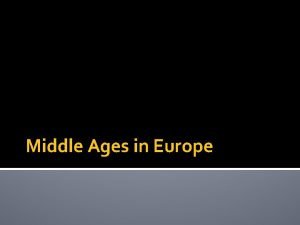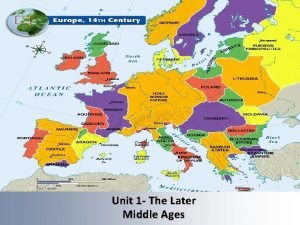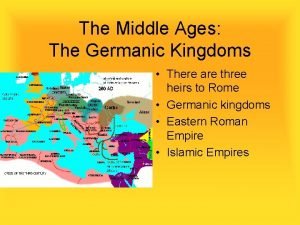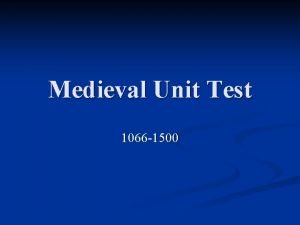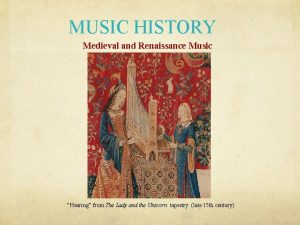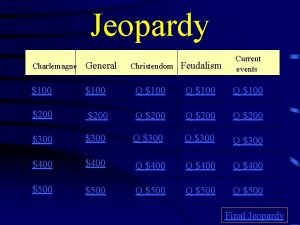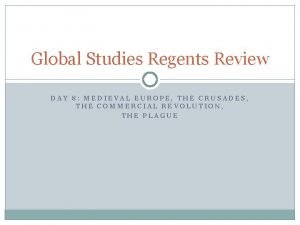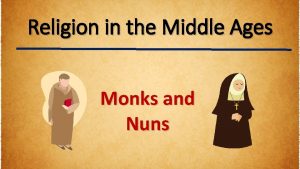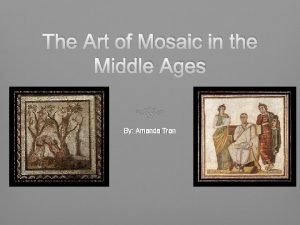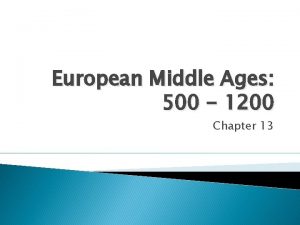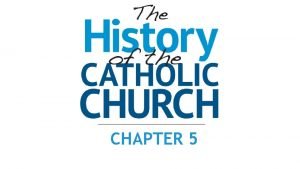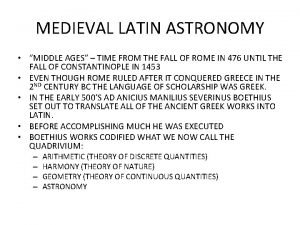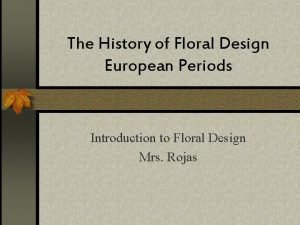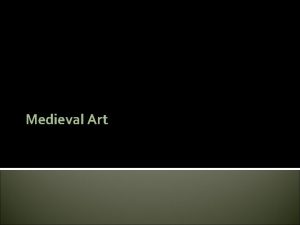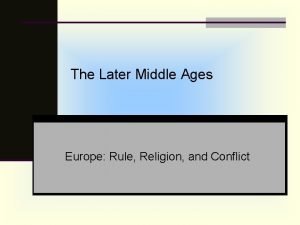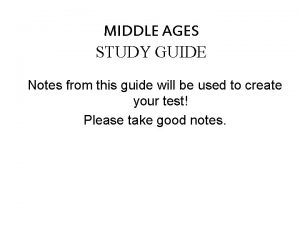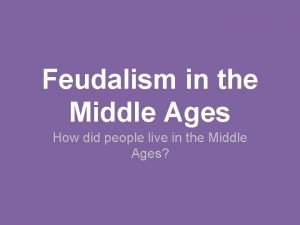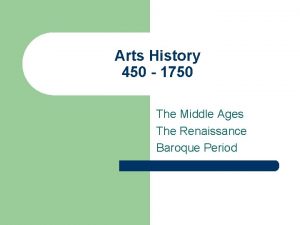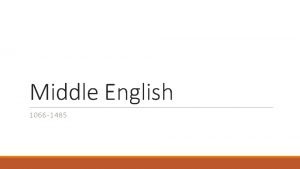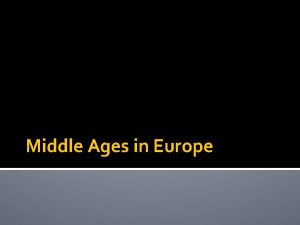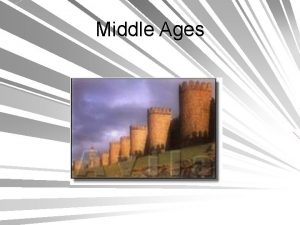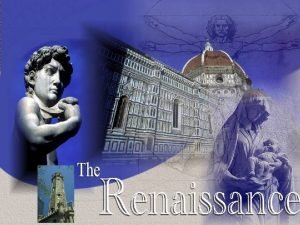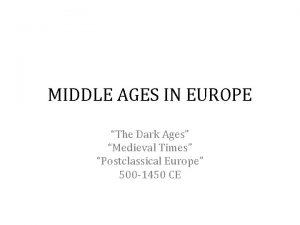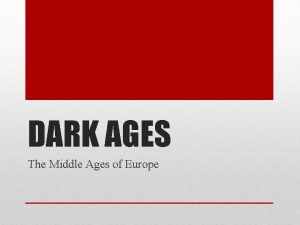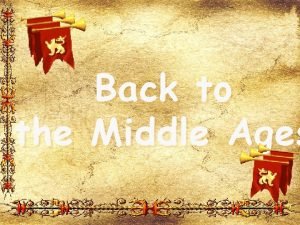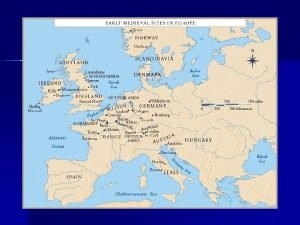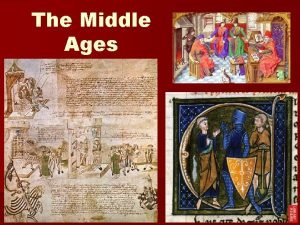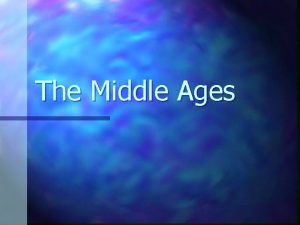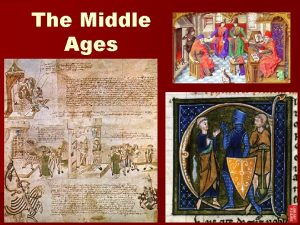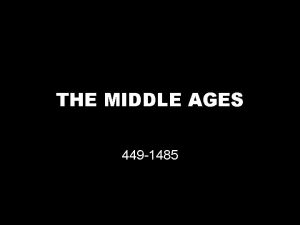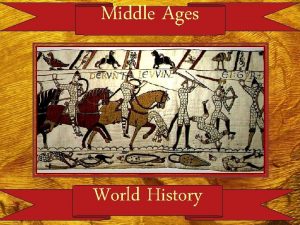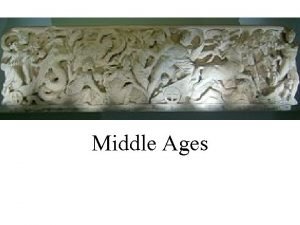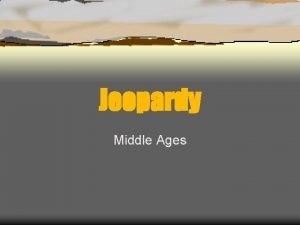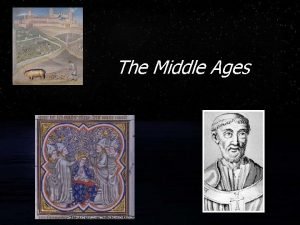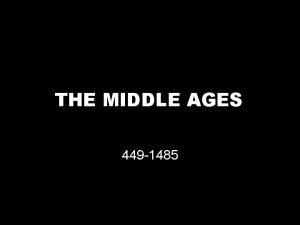Middle Ages in Europe The Middle Ages def



























- Slides: 27

Middle Ages in Europe


The Middle Ages – def. medieval period in Europe lasting from 500 – 1300 A. D. �Taking place as a result of the gradual decline of the Roman Empire �Primary unifying force in Western Europe = Roman Catholic Church (THE church)

The Middle Ages How? � 1) the Pope anointed Holy Roman Emperors � 2) missionaries carried Christianity to Germanic Tribes � 3) Church served social, political and religious needs of the people


Foundation of Early Medieval Society: 1. Classical heritage of Rome – Roman culture still important, even though in decline – giving way to Germanic culture 2. Christian Beliefs – most of Western Europe, including more Germanic Tribes 3. Customs of Germanic Tribes – ex: oral tradition of song and language, no written language, violence and warfare

Changes in Western Europe: 1. Disruption of Trade – frequent invasions caused trade to break down, causing a decline in cities and a lack of money in Western Europe 2. Downfall of Cities – cities were abandoned, lack of leadership 3. Population Shifts – people left cities for rural areas

Changes in Western Europe: 4. Decline of Learning – invaders couldn’t read or write, Roman culture in decline, knowledge of Greek nearly disappeared, only literate people = monks/priests 5. Loss of a Common Language – different dialects of Latin gave rise to Romance languages


Influence of the Roman Catholic Church in Early Middle Ages: 1. Roman authority declined, while church authority grew 2. Monasteries preserved Greco-Roman cultural achievements – monks were the few who could read and write = literate



Influence of the Roman Catholic Church in Early Middle Ages: 3. Missionaries carried Christianity and Latin alphabet to Germanic tribes. 4. Clovis converted the Franks to Christianity


Influence of the Roman Catholic Church in Early Middle Ages: 5. Pope Leo III anointed Charlemagne as the Holy Roman Emperor in 800 A. D. 6. Parish priests served religious and social needs of the people


The Rise of Feudalism: �Background: 1. Invaders destroyed Roman ability to protect people of Western Europe 2. people, in response to this lack of protection, entered into feudal agreements with landholding lords who promised them protection

The Rise of Feudalism: �Fief – piece of land �Lord – landowner, granted land to a vassal in exchange for loyalty and military service �Vassal – one who received land from a lord, pledged loyalty and military service �Serf – workers/peasants who were tied/bound to the land – worked to maintain the manor

The Rise of Feudalism: �Medieval Manor – lord’s estate, houses and land -had its own rigid class structure and selfsufficient economy


King Nobles/ Church Officials Knights Serfs

The Rise of Feudalism – Political and Social Organization of Medieval Europe Oath of loyalty/military support Loyalty/military King Grant Fief (land) Vassal (Lord) Shelter/food Knights Labor, rent Serfs and Peasants (90% of population) Shelter/food And protection

The Manor System – The Medieval Economic System � Manorialism � Self sufficient � Little reason to leave your manor.


The Manor System – The Medieval Economic System �Not a political unit (no voting), was a system of economic organization �No new ideas exchanged. �Technology slow to progress. �Little use of money. Wealth based on land.

Social Political Religious • Strict social hierarchy based on the feudal pyramid. • Feudalism – Kings and nobles exchange land for loyalty and protection. • Rise in the power of the Pope and Roman Catholic Church • Social Status determined by birth • Lack of social Mobility • Decentralized government • People followed religious Canon • Code of Chivalry Law – Led by Pope • Pope had power of excommunication

Intellectual • Decline in learning as population shifts to rural areas • Most people were illiterate • Priests and monks could read and write – wrote books, mostly religious Technological Economic • Manorialism • Technology slow • Manor system – to progress as exchange of ideas completely selfsufficient in that it declines. had everything • Most technology used that was needed for military or farming – Crossbow, armor, longbow, siege weapons, early guns, heavy plough, water and wind mills, mechanical clocks, stirrups, hourglass, printing press • Little use of money • Little to no trade • Pay 10% tithe to church
 Renaissance vs medieval art
Renaissance vs medieval art Why are the middle ages called the dark ages
Why are the middle ages called the dark ages Feudalism def
Feudalism def Middle ages def
Middle ages def Arts of emerging europe
Arts of emerging europe European middle ages map
European middle ages map Dark ages def
Dark ages def Germanic kingdoms
Germanic kingdoms The middle ages 1066 to 1485 unit test
The middle ages 1066 to 1485 unit test The middle ages spans nearly one thousand years
The middle ages spans nearly one thousand years Current events jeopardy
Current events jeopardy Middle ages regents questions
Middle ages regents questions Middle ages buildings
Middle ages buildings Monks and nuns in the middle ages
Monks and nuns in the middle ages Medieval period mosaic
Medieval period mosaic European middle ages chapter 13
European middle ages chapter 13 Similarities between middle ages and renaissance
Similarities between middle ages and renaissance Astronomy in the middle ages
Astronomy in the middle ages Middle ages floral design
Middle ages floral design Middle ages art characteristics
Middle ages art characteristics Early middle ages
Early middle ages Egyptians floral design
Egyptians floral design Empire period floral design
Empire period floral design Middle ages study guide answer key
Middle ages study guide answer key Feudal system in the middle ages
Feudal system in the middle ages High middle ages
High middle ages 450/1750
450/1750 The middle ages 1066 to 1485 unit introduction
The middle ages 1066 to 1485 unit introduction


